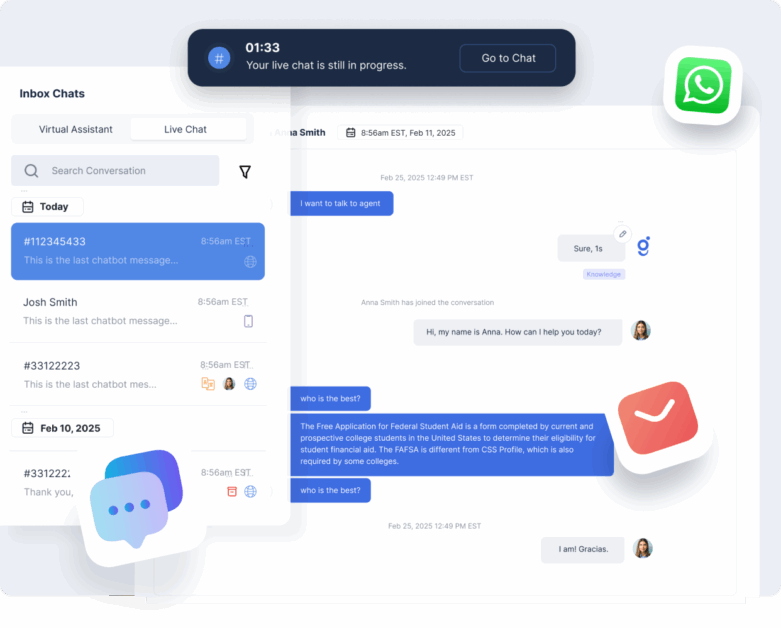Build vs. buy: What’s the best higher ed chatbot for universities?

It’s been a chaotic time for higher ed teams. To cut down on staff burnout while still reaching students effectively, Tech and Student Affairs leaders at colleges and universities are exploring new ways to serve students faster and more efficiently. One increasingly popular tool is the AI chatbot.
But as more institutions weigh their options, one key decision arises: should we build it ourselves, or buy a purpose-built solution?
With the emergence of no-code AI agent builders like Microsoft Copilot, Kore AI, Ada AI, and Hyro, building a chatbot internally may seem tempting. Institutions with strong IT departments often believe they can save money by leveraging these platforms. But is that the full story?
Below, we unpack the real costs of building versus buying, explore what DIY chatbot platforms miss, and show why Ivy & Ocelot is the best higher ed chatbot solution for universities today.
Why universities are considering the DIY route
“Do-it-yourself” chatbot platforms appeal to many institutions for their perceived affordability, built-in flexibility, and compatibility with enterprise tools already in place. Especially for universities with in-house development capacity or existing Microsoft infrastructure, tools like Copilot and Hyro offer an enticing possibility.
But flexibility often brings hidden costs – particularly in a complex, compliance-driven space like higher ed. And the burden of integration, content management, and upkeep quickly erodes the surface-level.
3 hidden costs of building a chatbot for higher education
While it may seem like a golden opportunity to save some costs on your institution’s techstack, building an AI chatbot for things like student support and FAFSA inquiries can end up costing more in maintenance, staffing, and compliance risks.
1. Staffing and maintenance overhead
Building and maintaining a custom AI chatbot requires far more than a one-time project sprint. Institutions often need to dedicate at least one fully benefitted FTE—costing up to $150K annually—to build, train, and maintain the system. This does not account for the time contributions of IT, enrollment, marketing, and academic support teams involved in the bot’s continued upkeep.
2. Delayed time-to-value
Internal projects often take 9 to 12+ months to reach deployment. From drafting knowledge bases to scripting workflows, testing integrations, and navigating internal red tape, institutions risk missing critical admissions, advising, or financial aid windows. That can mean real lost enrollment and student frustration.
3. Compliance and content burden
DIY platforms are not purpose-built for education, and they don’t come preloaded with domain-specific compliance features. That leaves internal teams to shoulder:
- FERPA, ADA, and Title IV compliance checks
- Ongoing accessibility audits
- Custom workflow development for each department
Without a higher ed-focused foundation, building a chatbot in-house can quickly become a full-time job.
What universities are missing with DIY chatbots
Most DIY or enterprise platforms like Copilot, Kore AI, Ada AI, and Hyro fall short in areas that matter most to student support and institutional effectiveness.
They typically:
Lack omnichannel engagement capabilities
By leaving out SMS, Telephony, or seamless email/chat transfer, these platforms limit accessibility and frustrates students who expect support across multiple channels.

Struggle to deliver verifiable responses linked to source material
In a recent Salesforce survey, almost 80% of students who report having a great university experience say they can easily get their questions answered at their school. Incorrect or flawed responses can erode trust and lead to misinformation or compliance issues.
Lose data and knowledge across departments
In a 2022 EAB report, 65% of higher ed leaders said streamlining data access to facilitate decision-making is a high priority. Disparate, disconnected knowledge and tracking can result in inconsistent answers and siloed support experiences.
Require institutions to manually build or upload every knowledge item
This places a heavy burden on already-swamped internal teams and delays time to value.
Provide little to no implementation or strategic guidance
A lack of a strategic vendor partner leaves institutions without the expertise needed to optimize and scale the solution, whether across departments or campuses.
Why future-ready institutions choose Ivy & Ocelot from Gravyty as their higher ed chatbot solution
If a higher ed team has decided to buy a customized, pre-built solution, it’s important to assess which one best suits your needs.
Ivy & Ocelot from Gravyty is not a generic chatbot platform retrofitted for higher education. It was purpose-built for higher ed from day one, with the use cases, integrations, compliance standards, and multi-department complexity of campuses in mind.
The platform comes loaded with thousands of curated Q&As tailored for student needs. Departments across admissions, enrollment, financial aid, advising, housing, IT, and more can deploy helpful content right away.
Mur Muchane
CIO, Wake Forest University
Omnichannel student support made easy
Communication is omnichannel by default. Whether via SMS, live chat, email, Telephony, phone, or social, Ivy & Ocelot ensures a consistent and accessible experience—available in over 100 languages.
Human-centered AI for automation and authenticity
Powered by a Hybrid AI architecture, Ivy & Ocelot blends retrieval-augmented generation with institution-specific data and verified content. This means every answer can be traced to its source, ensuring institutional control and student trust.
Fast implementation
Implementation is fast, with time to value measured in weeks, not months. With 30+ native higher ed integrations (including Banner, Slate, PeopleSoft, Canvas, Salesforce, and Symplicity), the platform snaps into your ecosystem without custom development.
Built for compliance, security & ethical AI
In higher education, data privacy and regulatory compliance are non-negotiable. Chatbots interacting with students and handling institutional data must meet strict standards around security, accessibility, and accountability. From FERPA protections to GDPR requirements and emerging frameworks like TX-RAMP and State-RAMP, the compliance landscape is complex and constantly evolving.
Gravyty’s Ivy & Ocelot platform is engineered to exceed these standards. It is fully compliant with:
- FERPA (Family Educational Rights and Privacy Act)
- HIPAA (Health Insurance Portability and Accountability Act)
- GDPR (General Data Protection Regulation)
- SOC 2 (System and Organization Controls)
- TX-RAMP (Texas Risk and Authorization Management Program)
- State-RAMP
- HECVAT (Higher Education Community Vendor Assessment Toolkit)
This extensive compliance portfolio gives institutions peace of mind that their AI solution is safe, secure, and legally sound.
Additionally, Ivy & Ocelot’s Hybrid AI architecture blends domain-specific training, institutional data, and retrieval-augmented generation (RAG). This ensures every answer is not only accurate and contextually relevant, but also:
- Traceable to its original source
- Aligned with institutional policies
- Governed by clearly defined AI guardrails
This ethical and transparent approach to AI empowers institutions to maintain control while still benefiting from next-generation technology. Students and families can interact with confidence, and IT leaders can trust that their digital investments are protected.
And the partnership doesn’t stop at go-live. Each institution receives hands-on support from a dedicated implementation team and customer success manager, plus regular optimization based on real student interactions.
The University of Houston
Ivy & Ocelot vs. other higher ed chatbots
While there are many solutions available for AI-powered chatbots, not all are the right fit for your higher ed institution. Some are stronger than others in areas like compliance, accuracy and strategic guidance. Let’s take a look at how Ivy & Ocelot from Gravyty stacks up against the competition.
Ivy & Ocelot vs. Microsoft Copilot
Microsoft Copilot is a general-purpose no-code builder with limited domain knowledge. It lacks FERPA-aware content, omnichannel communication tools, and higher ed-specific analytics. Ivy & Ocelot by contrast, offers a plug-and-play experience with compliance and prebuilt content built-in.
Ivy & Ocelot vs. Hyro
Hyro was designed for healthcare, not education. Its integrations, analytics, and communication channels reflect that. Ivy & Ocelot’s platform is tailored for student engagement and success, with features designed around the student lifecycle.
Ivy & Ocelot vs. Kore.ai
Similar to Hyro, Kore AI focuses heavily on IT and HR enterprise use cases—not education. Building a chatbot with Kore means extensive integration work and relying on generalized workflows. Ivy & Ocelot was built for higher ed and comes ready to support student needs from day one.
Cesar F.
Associate VP for Enrollment Management
To build or to buy? Final verdict
Yes, your IT team may have the capability to build a chatbot. But the question is: at what cost?
When factoring in staff time, compliance risk, delayed ROI, and the ongoing burden of updates and integrations, the cost of building often outweighs the investment in buying. Especially when buying gets you:
- Strategic guidance to grow and optimize
- Faster launch and time to value
- Prebuilt, higher ed-specific content
- Enterprise-grade integrations and support

Ivy & Ocelot goes beyond what other chatbots today offer to universities. It’s a comprehensive solution for digital transformation in higher education.



